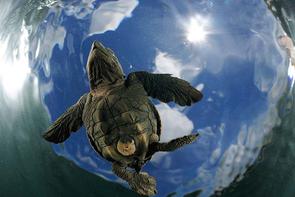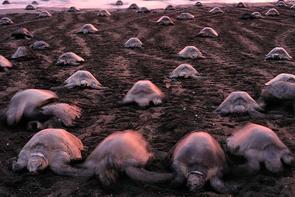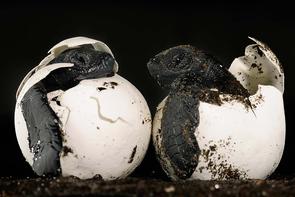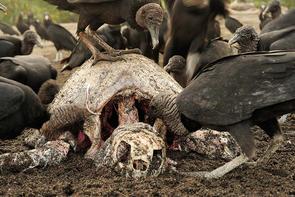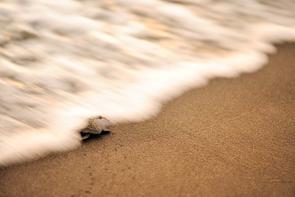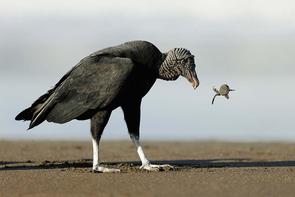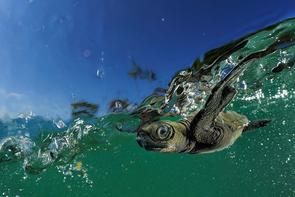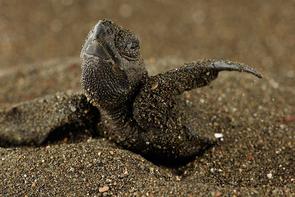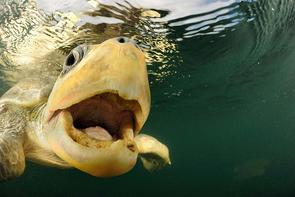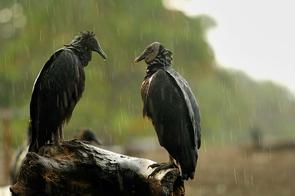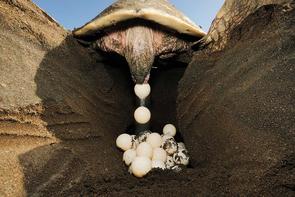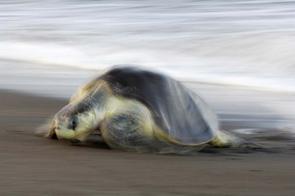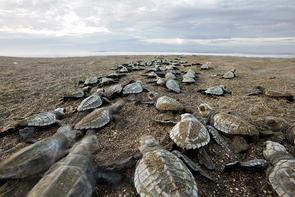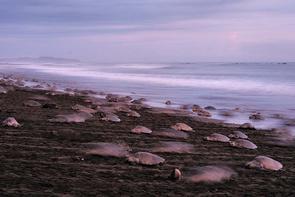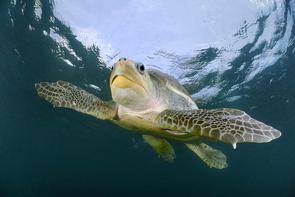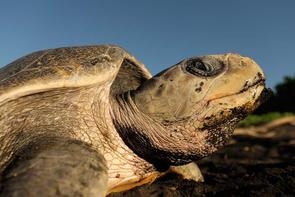Winner: Solvin Zankl - Germany
Solvin Zankl, born in 1971, studied biology and has been working full-time as a nature photographer since 1998. He allows his scientific background and his sense of aesthetics to flow into his photo reports. His work has won several international awards, and his report on biodiversity won first prize at the German Science Photography Prize 2008. His photographs appear regularly in leading journals and magazines around the world, such as Geo, National Geographic Magazine, Natural History Magazine and BBC Wildlife. It is typical for Solvin Zankl that he takes a lot of time on site for the documentation of animals and nature in order to learn to understand the behavior of the animals and to let the environment affect him. He spent months among penguins on the sub-Antarctic islands or under the rainforest canopy on the Amazon. His work is valued because he manages to give his motifs an emotional level through expressive perspectives, which gives the viewer the feeling of an experience.
www.solvinzankl.com
Project: The big comeback - nesting sea turtles in Costa Rica
Sea turtles play an important role in Solvin Zankl's life. At the age of 16 he did his first internship in sea turtle protection on Buck Island Reef National Monument in the archipelago of the American Virgin Islands. For the next eight years he worked on site every season. Nocturnal beach patrols, observation of the egg-laying females, marking of turtles, relocation of turtle nests and photo documentation were among his tasks. Even while he was studying biology, it always brought him back to the beach.
The photos of sea turtles, which were taken almost by the way, were successfully used in public relations. This encouraged Solvin in the following years to devote himself more to photography and ultimately to make it his profession. But as a professional wildlife photographer, it took more than ten years of abstinence to return to one of the most impressive sea turtle beaches in the world with new eyes and ideas.
It is Ostional Beach in Costa Rica. Turtles come here to lay their eggs all year round, at least one per night even outside the usual season. Three different species of sea turtles lay their eggs here, and it is one of only four beaches in the world where sea turtles lay their eggs in masses with tens of thousands of animals on some days, in what is known as an arribada. But this is also the only beach in the world where locals are actually allowed to collect sea turtle eggs for consumption.
For three weeks, Solvin stands on the beach at 3:00 a.m. every day with ready-to-use photo equipment for both underwater and land photography. When he discovers the first 50 turtle heads on the surface of the water at dawn, the joy is great. Minutes later, the first olive ridley sea turtles are ashore, followed by 100 more, followed by 1000 more, followed by ... he can't count them anymore. Like on an anthill, there is a constant coming and going.
In the following days Solvin Zankl is no longer alone on the beach with the animals. The event quickly got around, and the thousands of turtles will be joined by hundreds of locals who will harvest eggs from this arribada over the next 36 hours, and thousands of tourists who will be brought to this spectacle by bus. But despite everything, 50 days later, young animals will hatch from many of the eggs that have been laid and begin the dangerous start of a new sea turtle life.
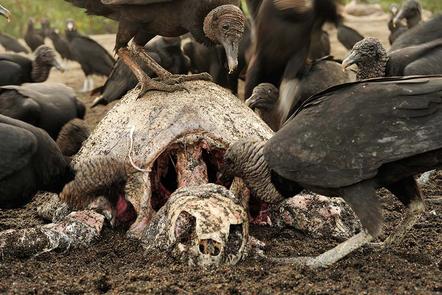
Live and die close together
The black vultures are sociable scavengers and birds of prey. They are out and about in large groups on the beach in Ostional on the Pacific coast of Costa Rica. There they lurk for hatching sea turtles or, on occasion, attack a half-decayed, washed-up animal. In less than half an hour this olive ridley sea turtle was completely skeletonized by the powerful birds.
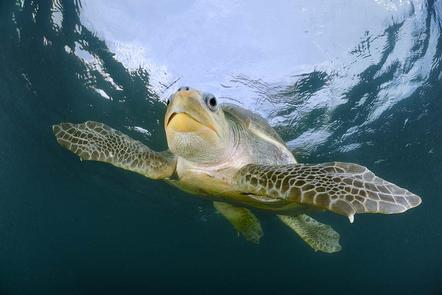
Sea turtle underwater flight
Like all sea turtle species, olive ridley sea turtles are perfectly adapted to life in the ocean. With the help of their large front fins, these animals “fly” through the water and can then easily leave any diver behind them. Once hatched on land and immediately crawled into the sea, sea turtles stay in their wet element forever - except for the brief egg-laying moments that this adult female is just preparing for in the offshore Pacific.
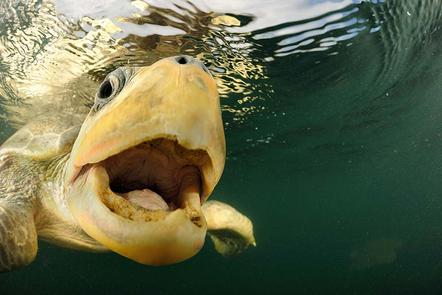
Edible?
Swimming olive ridley sea turtles are not very shy and curiously approach unknown objects. They have a wide range of prey from fish, snails, mussels and plankton organisms and are therefore quite willing to experiment when it comes to food. Fatally, this leads to the fact that they often swallow large amounts of floating plastic waste or fishing lures with hooks and often perish miserably. This turtle had nothing really edible in mind, possibly the curved windshield of the underwater housing looked like a jellyfish.
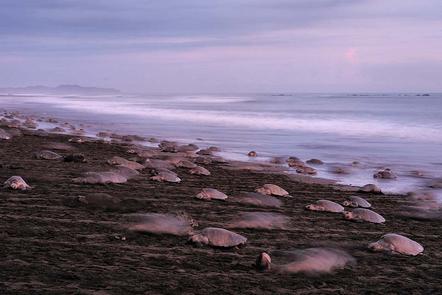
They are coming!
One of the peculiarities of the olive ridley sea turtle is their peculiarity of nesting in unimaginably large groups. When a so-called arribada (Spanish for arrival from sea) of the olive ridley sea turtles is in full swing, up to several hundred thousand females come to lay their eggs on the beach of Ostional for about seven consecutive nights. The spectacle continues into the morning hours and can be repeated at intervals of approx. 28 days, i.e. a lunar month, in the period from April to December. However, there are also failing arribadas, irregularities or shifts from one nesting beach to another over the years and decades.
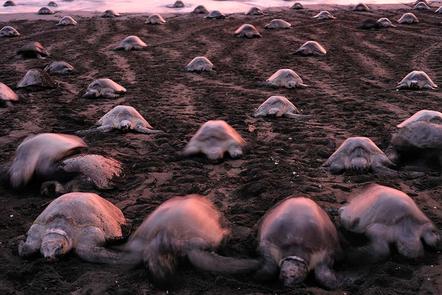
Mission reproduction
Within a week of an arribada, the beach transforms from a normal sandy area into a terrain that looks like it has been furrowed by tractor tracks. In the end, sea turtle eggs and their shells will be scattered everywhere on the surface, because the later nesting females often destroy the clutches of their predecessors when they dig their own nests. However, these losses are factored in to the strategy of mass nesting, which is only carried out by the olive ridley sea turtle and its Atlantic sister species, the Atlantic ridged turtle. The advantage that predators of the eggs and young animals are fed off by the extreme oversupply outweighs the disadvantage of the lack of space under natural conditions.
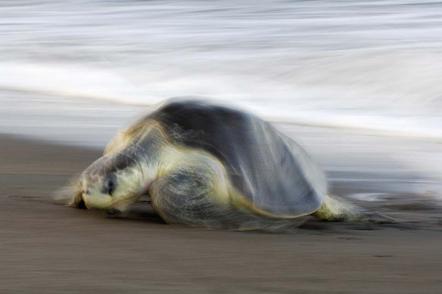
The shore leave
All year round, individual sea turtles of different species come ashore to lay their eggs on Ostional Beach. In the months of April to December, however, the arrival of an olive ridley sea turtle in the early morning hours can be the beginning of a monthly repetitive mass oviposition of hundreds of thousands of females of this species. The swimmers, who are so elegant and almost weightless under water, clearly have a hard time dragging themselves on land. When crawling up, the turtle repeatedly checks the sand with the tip of its beak. Their eggs will only have a chance of survival in dry, warm sand above the highest high water line.
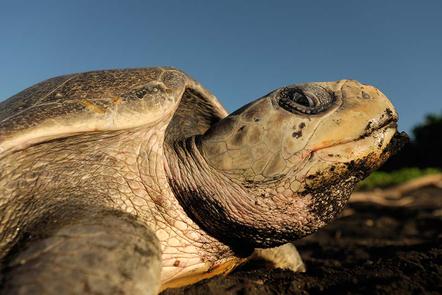
Primeval beach visitor
This olive ridley sea turtle has crawled on the beach in the sunny hours of the morning to lay its eggs. While other species of sea turtles only come ashore during the night, this rather small species is known to nest in light. Due to their lower body mass and the strong wind, they do not run the risk of dying from overheating as quickly.
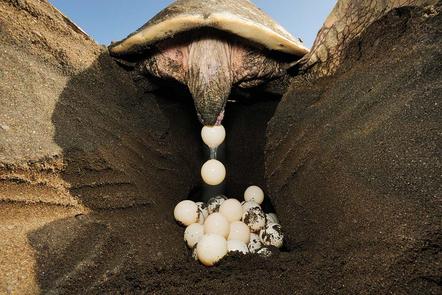
Eggs churning out
When an olive ridley sea turtle found a suitable place, it digs a hole one to thirty to fifty centimeters deep with its hind flippers. About a hundred soft-shelled eggs are placed in the nest, which is then carefully closed. Ostional is the only place in the world that allows locals to dig up the sea turtle nests at the beginning of an arribada and to remove the eggs for sale and consumption. This egg collection, legalized under certain conditions, is intended to prevent uncontrolled egg grabbing. A side effect is the possibility to photograph the falling eggs at the opened nest immediately before collecting the clutch, which is of course strictly forbidden otherwise.
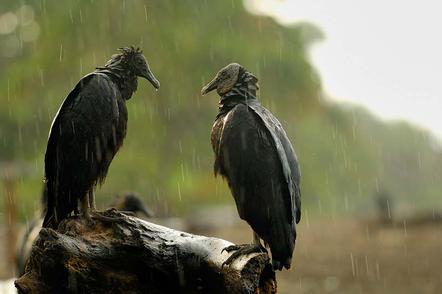
Rain in the land of milk and honey
Two black vultures, on the left a young animal with a black head, on the right an old animal with the typical gray, wrinkled skin, cannot be driven away from their vantage point on the Ostional beach by a rain shower. As soon as young sea turtles reappear on the sand surface, they will eat their next meal.
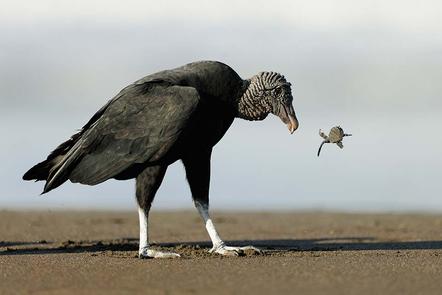
Easy loot
The vast majority of olive ridley turtles hatch under cover of night. Some of those who are still out on the sand in daylight fall victim to the black vultures. Since the vulture's throat is too narrow for the shell of their prey, they have to try to hold the turtles with their claws and tear them apart with their beak. Often they only eat the head or individual fins before picking up their next victim a few steps further.
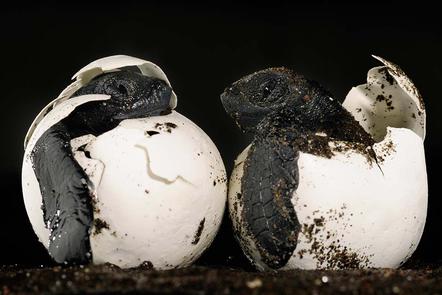
Blessing in disguise
These two hatched olive ridley sea turtles should be safe four inches below the surface of the sand in the midst of their siblings. Instead, they were dug up by stray house dogs, who probably recognize a nest by its smell at this stage. Apparently, for a dog, a ready-made young turtle is a more attractive treat than a fresh or hatched turtle egg. But even a dog is fed up at some point. Left by him carelessly, the two young animals must next face the ravens.
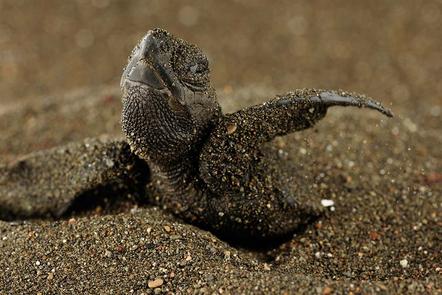
Fresh air
A young olive ridley sea turtle is the first to see the light of day in its nest. From the outside it is not possible to tell whether it is a male who is about to crawl into the sea for the rest of its life, or whether it is a female who will come to the same beach to lay eggs in many years' time. As with many reptiles, the incubation temperature decides during development about whether a male or female is growing up. The sex ratio in a turtle population is therefore determined by the temperature distribution within a nest and by the differences between the different clutches.
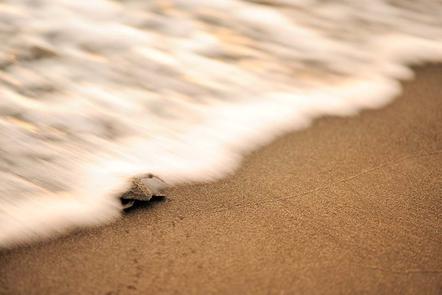
Run, Baby, run!
After a breeding period of almost two months in the warm sand, the young turtles hatch almost simultaneously. A joint effort is necessary to master the multi-day ascent through the at least thirty centimeter thick layer of sand above them. Once on the surface, they immediately set off on the dangerous route to the water - the large group increases the chances of the individual. The brightness of the horizon over the sea reliably indicates the direction, unless human lights on the land side disrupt the age-old orientation system.
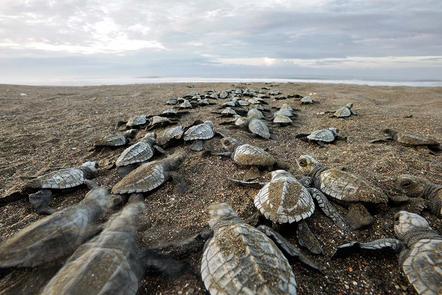
The perfect wave
Despite the lurking vultures, forest storks, dogs and crabs, the young olive ridley sea turtle made it to the washing line. But there are also dangers in the water: predatory fish from below and frigate birds from above. It is estimated that only one in a thousand young sea turtles will reach adulthood.
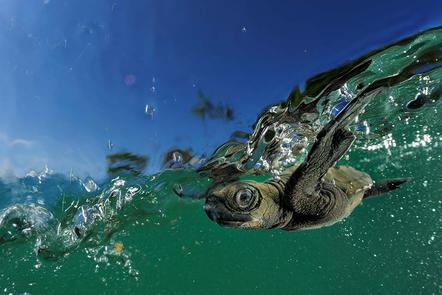
In their element.
As soon as they can no longer feel the solid sand under their fins, the small sea turtles switch from crawling to the synchronous "wing beats" of their aquatic locomotion. Very energetically and unexpectedly quickly they cross the surf zone. They usually swim under the surface of the water and only occasionally appear with their heads stretched high to breathe.
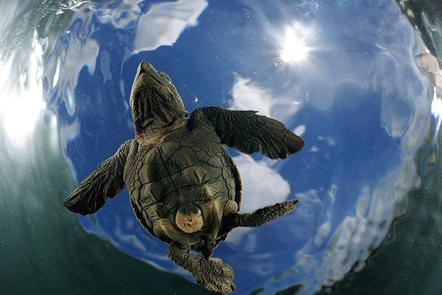
Good luck!
Their reserves of strength from the yolk remnants, which are sometimes still visible, will now help the young sea turtles to swim almost continuously for a whole day. The direction of the waves against which the sturdy little ones brace themselves in order to leave the coast behind them serves as a guide. For males it is a goodbye forever, the females will with a lot of luck return to this place after fifteen to thirty years with about a hundred fertilized eggs in their belly.












